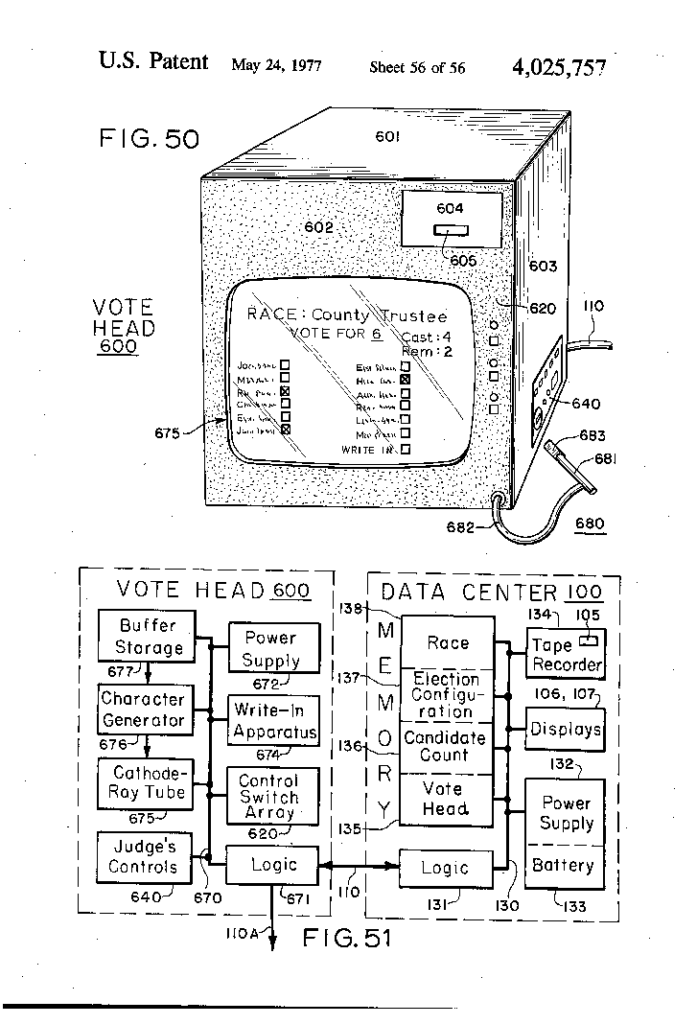As a fun distraction from the current election cycle here in the US, we’d like to share with you the patent history of voting machines. The way we vote in the US has changed over the years, as have the various mechanisms used for voting.
Voting technologies have developed in parallel with advances in information processing technology. Paper ballots were the only means of voting until the late 1800s when automation began to be used to assist in counting votes. Today, almost all ballots in the US are counted using computer-assisted technologies.
Thomas Edison, best known for inventing the lightbulb, received his first patent for his ‘electric’ improvement on previous voting methods, which he named the “electrographic vote-recorder”. He was issued his patent, numbered 90,646, on June 1, 1869.

Edison’s device allowed individuals to vote “yes” or “no” by flipping a switch. Although his invention was intended for use by government legislators, it motivated others to invent the many subsequent versions of voting machines US citizens have used since that time.
Types of Voting Technologies
In the US, generally, five types of voting machines have been used to cast votes: hand-counted paper ballots, mechanical lever machines, punch-card machines, scanned paper ballots, and direct-recording electronic devices.
Hand-counted paper ballots are marked by hand, indicating the voter’s choice next to a candidate. Ballots are then manually counted, usually in the precinct where they were cast. Over the years, hand-counted paper ballots have become quite rare in the United States. On the other hand, some security experts still consider paper ballots to be the most secure form of voting.
Lever Voting Machines. The first mechanical lever voting machine (US 415,549) was granted to Jacob H. Myers in 1889. The Myers Automatic Booth Lever Machine was first used in 1892. By 1930, lever machines of varying designs had been installed in almost every major city in the United States.

When the voter enters the voting machine, he or she pulls a large lever that pulls a curtain around the voter, ensuring privacy. The voter picks their choice by depressing a lever next to the preferred candidate. Once the voter is finished, they pull the large lever again, which opens the curtain and counts the vote. The machine is then ready for the next voter.
Punch Cards. The first punch card device was patented by Herman Hollerith in 1889 (US 395,782). It was originally used to compile data for the 1890 US Census.

The punch card voting system utilized a pre-printed card. Voters chose their candidates by punching through the appropriate hole using a stylus or a pen-shaped tool. The removal of a chad left a hole that is counted as a vote.
The first commercially successful punch-card voting system was not developed until 1965 when Joseph P. Harris developed the Votomatic punch-card system (US3,201,038).

Punch card voting machines remained the most common voting method until they were criticized after the 2000 Presidential election involving Florida’s “hanging chads” incident. In response, Congress passed the Help America Vote Act (HAVA) in 2002, which banned the use of lever machines and punch cards in federal elections. The effect of HAVA was the decline in the use of punch cards and lever machines, while the use of the two technologies described below grew exponentially.
Scanned Paper Ballots. A paper ballot is marked with a black pen or marker to fill in a circle next to the preferred candidate’s name. The voter then places the ballot in a scanner that sits on top of the ballot box and the ballot is scanned as it’s being deposited. Votes are counted at the end of election day by running a procedure on the scanner that prints out the vote totals in that precinct or centrally.
James O. Narey and William Saylor were granted a patent in 1977, for the first model of a precinct-based optical scan system (US 4,021,780). Modern versions are in use today.

Direct Recording Electronic (DRE) Voting Machines. DREs first came into widespread use in the 1970s. DREs, today are essentially portable computers that have been configured to display ballot choices and record votes by pressing on a touch screen.
McKay et al. developed a concept for an electronic voting machine, known as Video Voter for which they were granted a patent on February 19, 1974 (US 3,793,505). The invention was further developed and granted another patent on May 24, 1977, (US 4,025,757). DREs are currently the most technologically advanced voting systems.

Do you know what voting equipment is used in your state? This table contains the voting equipment used by each state for the general election as of August 13, 2024.
Undoubtedly, voting technology has come a long way, and we will likely see further innovation in voting methods in the future.
*The data for this article was consolidated from the following resources:
USPTO, Britanica ProCon.org, The Council of State Governments (Morgan Thomas), MIT Election Data + Science Lab, BallotPedia, Tech times (J.E. Reich) & Technologists as Political Reformers: Lessons from the Early History of Voting Machines (Douglas W. Jones)




